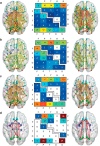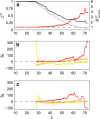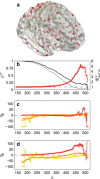Developmental Changes in Brain Network Hub Connectivity in Late Adolescence
- PMID: 26085632
- PMCID: PMC6605159
- DOI: 10.1523/JNEUROSCI.5043-14.2015
Developmental Changes in Brain Network Hub Connectivity in Late Adolescence
Abstract
The human brain undergoes substantial development throughout adolescence and into early adulthood. This maturational process is thought to include the refinement of connectivity between putative connectivity hub regions of the brain, which collectively form a dense core that enhances the functional integration of anatomically distributed, and functionally specialized, neural systems. Here, we used longitudinal diffusion magnetic resonance imaging to characterize changes in connectivity between 80 cortical and subcortical anatomical regions over a 2 year period in 31 adolescents between the ages of 15 and 19 years. Connectome-wide analysis indicated that only a small subset of connections showed evidence of statistically significant developmental change over the study period, with 8% and 6% of connections demonstrating decreased and increased structural connectivity, respectively. Nonetheless, these connections linked 93% and 90% of the 80 regions, respectively, pointing to a selective, yet anatomically distributed pattern of developmental changes that involves most of the brain. Hub regions showed a distinct tendency to be highly connected to each other, indicating robust "rich-club" organization. Moreover, connectivity between hubs was disproportionately influenced by development, such that connectivity between subcortical hubs decreased over time, whereas frontal-subcortical and frontal-parietal hub-hub connectivity increased over time. These findings suggest that late adolescence is characterized by selective, yet significant remodeling of hub-hub connectivity, with the topological organization of hubs shifting emphasis from subcortical hubs in favor of an increasingly prominent role for frontal hub regions.
Keywords: MRI; adolescence; connectome; development; graph theory; structural connectivity.
Copyright © 2015 the authors 0270-6474/15/359078-10$15.00/0.
Figures




References
-
- Ahuja RK, Magnanti TL, Orlin JB. Network flows: theory, algorithms, and applications. Upper Saddle River, NJ: Prentice Hall; 1993.
-
- Colizza V, Flammini A, Serrano MA, Vespignani A. Detecting rich-club ordering in complex networks. Nat Phys. 2006;2:110–115. doi: 10.1038/nphys209. - DOI
Publication types
MeSH terms
LinkOut - more resources
Full Text Sources
